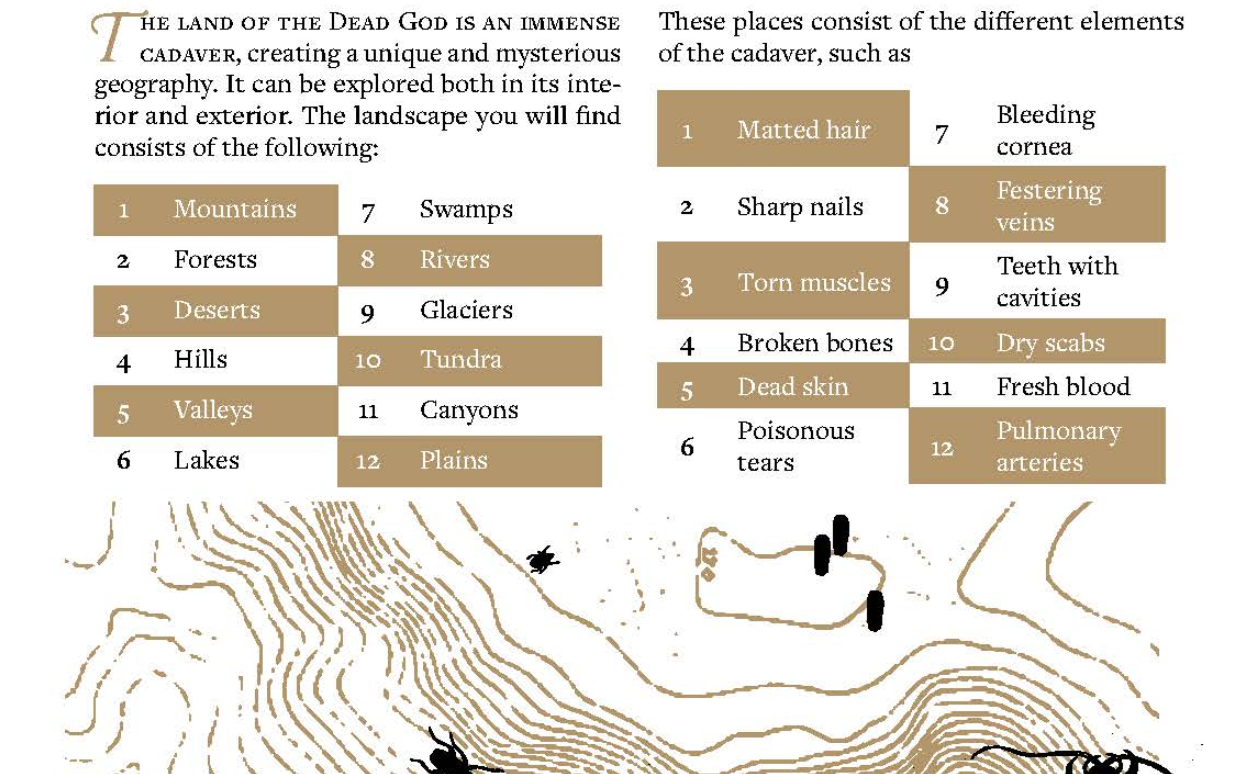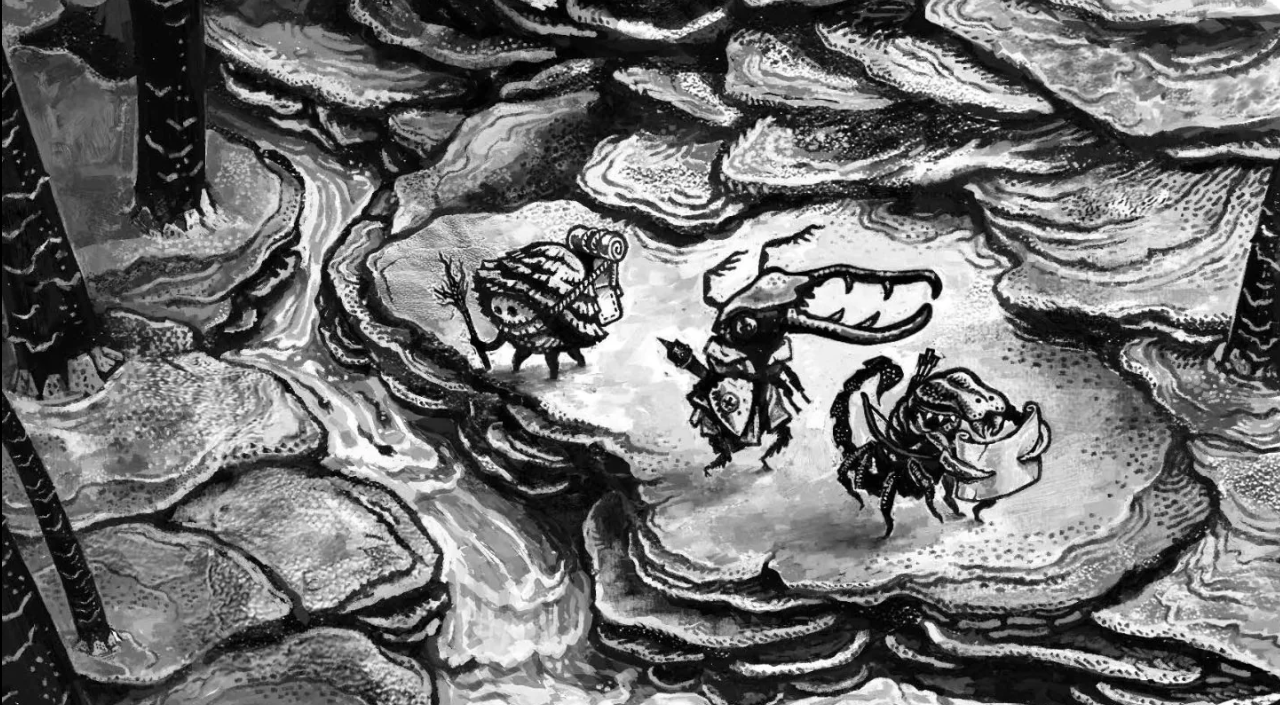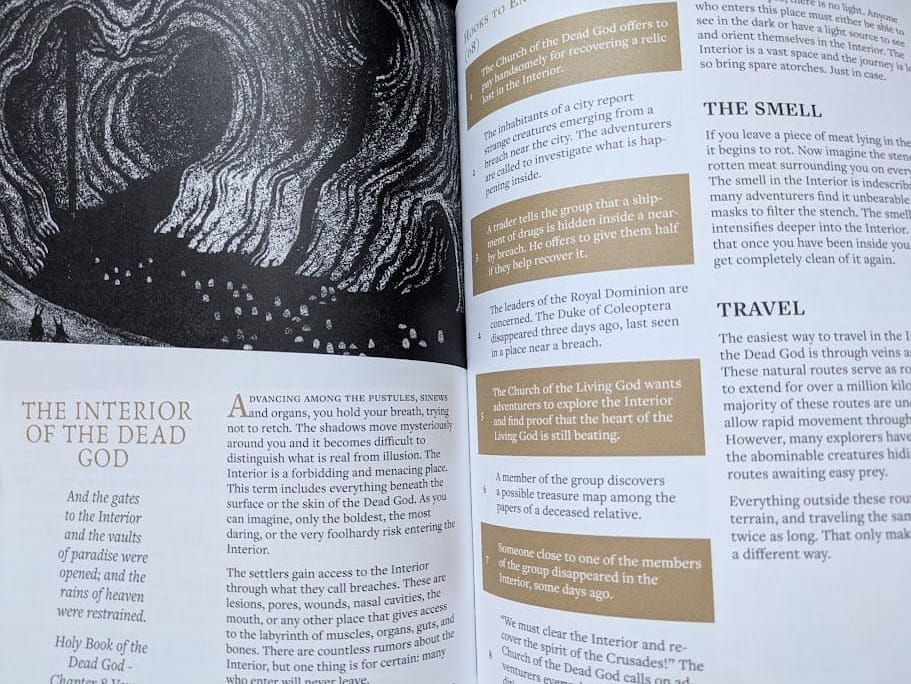
Settlers of a Dead God brings grime, terror, and mystery to its insectoid player characters, crawling their way on and through their world: the corpse of a decaying giant. There’s a lot to say for the weirdness and potential of this book, brought out by an alien, organic art design, but the details of its delivery have less to recommend them. The book is usable, and its ideas are well worth digging into, but it will take some work to tease a great campaign out of the materials contained herein. At minimum, there’s novelty to the many cults and factions Settlers brings with it, and the wars they wage into their mysterious host organism.
Though usable with many OSR systems, this is primarily a setting book for Old School Essentials. OSE has an interesting pedigree; rather than a new system itself, it’s a presentation of the Basic/Expert sets from the original Dungeons and Dragons, re-organized to be easier to learn and reference. Mostly the same material, but far more approachable. The basic rules are available for free if you’re interested. Settlers’ take on dungeon crawling is delving into the body of the Dead God, your world, and uncovering secrets within. Treasure and revelations are said to be buried deep within, but warped monstrosities, lethal radiation, and a rotting landscape threaten any who venture within.

The story being told here is a good one, though I would rather it were told a little differently. You’ll find out the nature of the setting and its inhabitants in large blocks of text, one after another, interspersed with random tables and rules about the map. It’s not bad exactly, but much of the bulky lore is sandwiched right next to the rules text. It takes a thorough read-through and notes to get through the first time. That’s fine, and not a problem for an RPG setting. It’s at the table where you’ll have more issues, finding which sections contain which piece of relevant information. The organization is not friendly. Important rules references are scattered throughout the book without clear reasoning or consistency.
The larger issue comes from the nature of the crawl itself. We don’t have a map of the Dead God, as the insects aren’t certain what form it takes. It could be a human or alien or something else entirely. So you move forward via hexes of…what? The God is not organized in any way we can detect. Its setting has details about what settlements or resources or adventures you could find in the many body parts, like arms and the head and the interior, but you have no idea where these things are in relation to one another. The random locations have no weight based on proximity, so you could go directly from a glacier in teeth with cavities to deserts in the pulmonary arteries. Maybe the God is supposed to be contorted strangely in death. At a total length of 200 km, with you traveling 1 km per day, it’s enormous, but large enough that you should have some idea of the shape of things.

The many places and people’s you’ll meet on the Dead God are interesting enough that this is still very worth considering. Kingdoms and religions each differ in wild, decaying geography, and what they think about the secret history of the world. Settlers doesn’t unpack all of the potential of those ideas. Even though this is a small package, coming in at 92 pages, it feels like the book doesn’t cover as much ground as it needs to. I don’t need every mystery solved for me, especially not in a book bursting with as many weird, inspiring ideas like this one. But the dark visions that start to eat at you as you read are left without answer, asking you to put in a lot of work once you’ve made your way through.
These issues are less with the lore than the mechanics. Lorewise, as much as there is interest in the many hooks and factions, the meat of the adventures presented aren’t that different from normal D&D: head out, find treasure, come back and level up. Many of the events on random tables could come out of any fantasy setting, regardless of the fact that you’re insect people living in a giant corpse. Most of the random tables lack mechanics. That’s generally fine; this is a generic setting book for OSR, where the stats are easy to work on. The problem comes in where the entries are in that realm of lacking description or generic so that they aren’t appreciably different from one another. For the relic generator, what is the important difference between Faithful Esophagus, Sacrosanct Pancreas, and Sacred Brain? There isn’t enough real connective tissue in here to use this as a hexcrawl, not without some hard work on the DM’s end. Once you’ve figured out how you want to approach the setting, there is a lot of intrigue to uncover.

As the exterior of the God is covered in cities and insects harvesting its parts for their use, the interior has dark monstrosities hiding treasure…of some kind. Again, it’s not clear what the real importance of the interior really is. Maybe all the theories are wrong, or maybe there is something fundamental buried there. I am happy to come up with ideas on my own, like a cache of alien metal from the bullet that killed the God, but the lack of direction in Settlers goes a step too far. The capacity for horror and survival exploration is nonetheless strong. You’ll have to outfit your characters with anti-radiation gear, keep track of light sources, and be wary of a constantly shifting interior as you fight through hungry monstrosities. The central loop of going in, getting treasure, and spending that treasure on better equipment is compelling. Equipment can be metal or, more commonly, made from the Dead God’s bones. Bone objects are subject to breaking over time, but are far less expensive.
Mechanically, there are many tables dealing with the nature of the landscape and the effects of radiation or hostile bodily gasses. You can also play as 6 types of insects, each with their own strengths and weaknesses. All of the insects share the book’s main atmosphere of weird inhumanity, like the Fungoid’s extendible limbs. There is a question of balance here, as some species have dark vision, but the Fungoids are totally immune to radiation and poison. As each class has some kind of huge strength, like the Bee’s flight or the Scarafajus’ ability to burrow. Most interesting are the mutated, nigh-Lovecraftian creatures that come in the minimal, 19-entry antagonist section. Ideally things would get weirder and more dangerous the deeper you get into the interior, closing in on some revelation. Instead, the book doesn’t have much consideration for depth or increasing threat beyond a few mentions. There are also some new spells to fit with this fetid world, like the ability to summon up a geyser of pus from the Dead God’s skin.

The book ends with a sample adventure, that for all the surreal horror of this setting is extremely mundane. The dungeon it includes is usable and fun, though the adventure as a whole doesn’t engage enough with this setting’s most interesting ideas. $28.00 for physical + pdf is not a bad deal, but there’s no mistaking that this book doesn’t feel as complete as it could. There’s a lot of page space taken up by not a lot of information, mechanically or thematically. You can pull some inspiration from this, and run a few adventures, but building it out into a complete game is a large task. Compared to other weird exploratory settings, where I feel like I got more use out of less text and page space, Settlers of a Dead God leaves me with an impression of wonder and mystery as much about its design as the setting itself.
Setters of a Dead God
Alright
The idea of insects delving into their Dead God’s theology and organs is fascinating. Dark and dangerous, I love the adventures that Settlers promises, though not the ones it delivers. With so much unsaid in the lore, the rules, and the setting, this is most recommended for experienced DMs who can compensate for its limited assistance.
Pros
- A mysterious, dangerous, and inventive setting
- 6 classes covering exotic insect types
- Disparate factions, locations, and ecologies promise a world of adventure
Cons
- Questionable organization makes rules difficult to locate
- Hex-crawling will be hard with the lack of direction over location and distance
- With 19 enemies and few treasures, there’s just not much material here
This review is based on a retail copy provided by the publisher.
